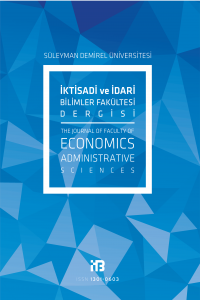21. YÜZYILDA GÖÇ OLGUSU: ULUSLARARASI GÖÇ TEORİLERİNİN EKONOMİ POLİTİĞİ
Göç, Uluslararası Göç Teorileri, Arap Baharı, Suriye, Ekonomi-politik
MIGRATION FACT IN THE 21ST CENTURY: THE POLITICAL ECONOMY OF INTERNATIONAL MIGRATION THEORIES
Migration, international migration theories, Arab Spring, Syria, economy-politics,
___
- ARANGO, J. (2000). Explaining Migration: A Critical View. 283-296.
- BALLYN, S. (2011). “The Why and the ‘Therefore’ of Human Migration: A Brief Overview”, s.6-15, (Ed.) Renes, M., Lives in Migration: Rupture and Contunity, Australian Studies Centre Publications.
- BRETTEL, C.B. & HOLLIFIELD, J.F. (2000). “Migration Theory: Talking Across Disciplines”, New York: Rouledge.
- BODVARSSON, Ö.B. & BERG, H.V. (2013). “The Determinants of International Migration: Theory”, s.27-57, (Ed.) Bodvarsson, Ö.B. & Berg, H.V., The Economics of Immigration, Springer: New York.
- DE HAAS, H. (2010). “Migration and Development: A Theoretical Perspective”, International Migration Review, 44(1); 227-264.
- DEWAARD, J., KIM, K. & RAYMER, J. (2012). “International Migration Systems: Evidence from Harmonized Flow Data. Demography, 49(4); s.1307-1333.
- FAWCETT, J.T. (1989). “Networks, Linkages and Migration Systems”, International Migration Review, 23(3); 671-680.
- GRIGG, D.B. (1977). “E.G. Ravenstein and the Laws of Migration”, Jornal of Historical Geography, 3(1), 41-54.
- HAGEN-ZANKER, J. (2008). “Why do People Migrate? A Review of the Theoretical Literature”, MPRA Working Paper.
- IOM, (2004). International Migration Law: Glossary on Migration. International Organization for Migration: Switzerland.
- KRIGER, H. (2004). “Migration Trends in an Enlarged Europe”, European Foundation fort he Improvement of Living and Working Conditions.
- KUREKOVA, L. (2011). “Theories of Migration: Conseptual Review and Emprical Testing in the Context of the EU East-West Flows”, Interdisciplinary Conference on Migration: Economic Change, Social Change için hazırlanmıştır, 06-09 Nisan 2011, University College London.
- LAUBY, J. & STARK, O. (1988). “Individual Migration as a Family Strategy: Young Women in the Philippines, Population Studies, 42(3); 473-486.
- LEE, E.S. (1966). “A Theory of Migration”, Demography, 3(1); 47-57.
- MABOGUNJE, A.L. (1970A). “Systems Approach to a Theory of Rural-Urban Migration”, Geographical Analysis, s.1-18.
- MABOGUNJE, A.L. (1970b). “Migration Policy and Regional Development in Nigeria”, The Nigerian Journal of Economic and Social Studies, 12(1); s.243-262.
- MASSEY, D.S., ARANGO, J., HUGO, G., KOUAOUCI, A., PELLEGRINO, A. & TAYLOR, J.E. (1993). “Theories of International Migration: A Review and Appraisal”, Population and Development Review, 19(3); 431-466.
- MASSEY, D.S. (1999). “Why Does Immigration Occur? A Theoretical Synthesis”, s.34-52, (Ed.) Hirschman, C., Kasinitz, P. & De Wind, J., The Handbook of International Migration: The American Experience, Russell Sage Foundation: New York.
- PETERSEN, W. (1978). “International Migration”, Annual Review of Sociology, (4): 533-575.
- PORTES, A. (1997). “Immigration Theory for a New Century: Some Problems and Opportunities, The International Migration Review, 31(4); 799-825.
- RAVENSTEIN, E.G. (1885). “The Laws of Migration”, Journal of the Statistical Society of London, 48(2); 167-235.
- SANDAL, E.K., HANÇERKIRAN, M. & TIRAŞ, M. (2016). “Türkiye’deki Suriyeli Mülteciler ve Gaziantep İlindeki Yansımaları”, Gaziantep University Journal of Social Sciences, 15(2), s.461-483.
- SJAASTAD, L.A. (1962). “The Cost and Returns of Human Migraiton”, Journal of Political Economy, 70, 80-93.
- STARK, O. & BLOOM, D.E. (1985). “The New Economics of Labor Migration”, The American Economic Review, 75(2); 173-178.
- OLEJAROVA, E. (2007). “Labor Migration As a Socio-Economic Phenomenon: Slovakia and the Czech Republic in a Comparative Perspective”, Central European University, International Relations and European Studies
- TODARO, M.P. (1980). “International Migration in Developing Countries: A Survey”, s.361-402. (Ed.). Easterlin, R.A. Population and Economic Change in Developing Countries. The University of Chicago Press: London.
- TODARO, M.P. & MARUSZKO, L. (1987). “Illegal Migration and US Immigration Reform: A Conceptual Framework”, Population and Development Review, 13(1); 101-114.
- UNHRC. The New York Declaration for Refugees and Migrants. http://www.unhcr.org/584689257.pdf. Erişim Tarihi: 19.12.2017.
- ZIPF, G.K. (1946). “The P1P2/D Hypothesis: On The Intercity Movement of Persons”, American Sociological Review, 11(6); 677-686.
- https://www.voanews.com/a/us-backs-out-of-migration-pact/4147078.html. Erişim Tarihi: 20.12.2017
- http://www.un.org. UN Department of Economic and Social Affairs, Population Division, International Migration. Erişim Tarihi: 20.12.2017
- ISSN: 1301-0603
- Yayın Aralığı: Yılda 3 Sayı
- Başlangıç: 1996
- Yayıncı: Süleyman Demirel Üniversitesi
AB - TÜRKİYE İLİŞKİLERİNDE GÖÇ: İLERLEME RAPORLARI ÜZERİNE İÇERİK İNCELEMESİ
Nermin AYDEMİR, Gökberk KESKİN
GÖÇ KRİZİNİN, BREXIT KARARINA VE AVRUPA BİRLİĞİ’NİN GELECEĞİNE MUHTEMEL ETKİLERİ
KONAR-GÖÇERLİKTEN YERLEŞİKLİĞE, YÜZER-GEZERLİKTEN YERELLİĞE GÖÇ...
AVRUPA BİRLİĞİ’NDE İSTENEN GÖÇMEN PROFİLİ ANALİZİ: EKONOMİK GÖÇMEN Mİ, POLİTİK GÖÇMEN Mİ?
AVRUPA’DA YAŞAYAN TÜRKİYELİLERE DAİR GURBETÇİ VE ALMANCI SÖYLEMLERİNİN YENİDEN DÜŞÜNÜLMESİ
21. YÜZYILDA GÖÇ OLGUSU: ULUSLARARASI GÖÇ TEORİLERİNİN EKONOMİ POLİTİĞİ
METROPOLLERDE YAŞAYAN SURİYELİLERİN YAŞAMLARINDA SİVİL TOPLUM KURULUŞLARININ ROLÜ: İZMİR ÖRNEĞİ
ULUSLARARASI GÖÇ, KİMLİK VE MEKÂNSAL KÜMELENME-AYRIŞMA
TÜRKİYE, MISIR, IRAK, ÜRDÜN VE LÜBNAN’DA BULUNAN SURİYELİ MÜLTECİLER: RAKAMLARLA GERÇEKLER
MÜLTECİ SORUNUNUN ÇÖZÜMÜNE İLİŞKİN YENİ BİR YAPILANMA: GÖÇ İDARESİ GENEL MÜDÜRLÜĞÜ
